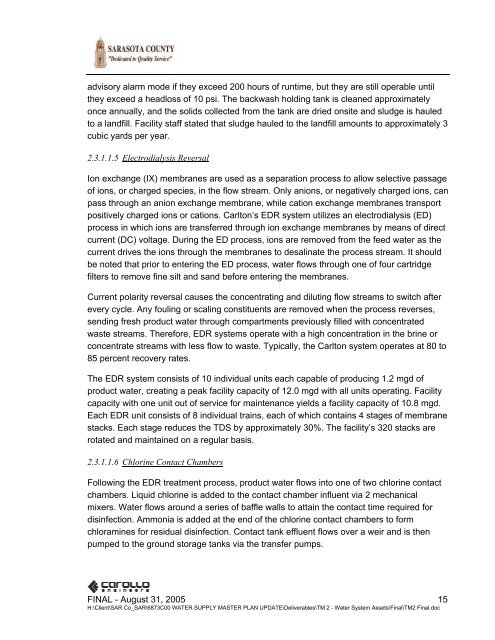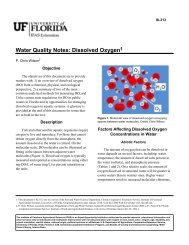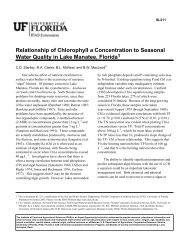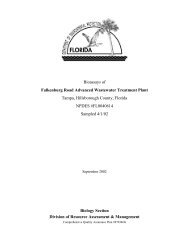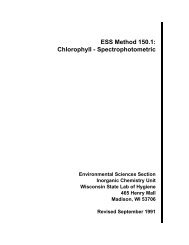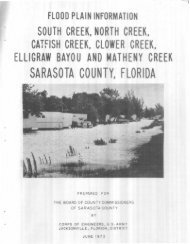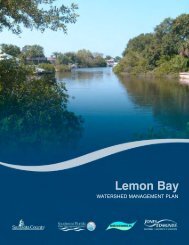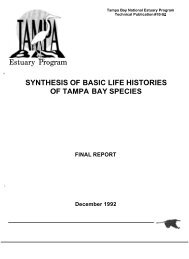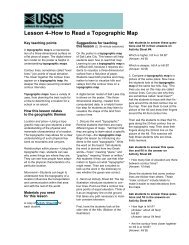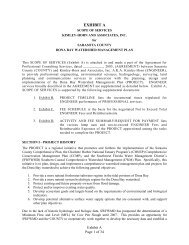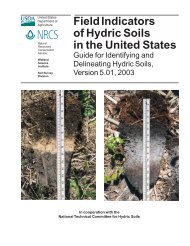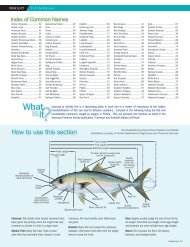CLIENT NAME - Sarasota.WaterAtlas.org
CLIENT NAME - Sarasota.WaterAtlas.org
CLIENT NAME - Sarasota.WaterAtlas.org
You also want an ePaper? Increase the reach of your titles
YUMPU automatically turns print PDFs into web optimized ePapers that Google loves.
advisory alarm mode if they exceed 200 hours of runtime, but they are still operable untilthey exceed a headloss of 10 psi. The backwash holding tank is cleaned approximatelyonce annually, and the solids collected from the tank are dried onsite and sludge is hauledto a landfill. Facility staff stated that sludge hauled to the landfill amounts to approximately 3cubic yards per year.2.3.1.1.5 Electrodialysis ReversalIon exchange (IX) membranes are used as a separation process to allow selective passageof ions, or charged species, in the flow stream. Only anions, or negatively charged ions, canpass through an anion exchange membrane, while cation exchange membranes transportpositively charged ions or cations. Carlton’s EDR system utilizes an electrodialysis (ED)process in which ions are transferred through ion exchange membranes by means of directcurrent (DC) voltage. During the ED process, ions are removed from the feed water as thecurrent drives the ions through the membranes to desalinate the process stream. It shouldbe noted that prior to entering the ED process, water flows through one of four cartridgefilters to remove fine silt and sand before entering the membranes.Current polarity reversal causes the concentrating and diluting flow streams to switch afterevery cycle. Any fouling or scaling constituents are removed when the process reverses,sending fresh product water through compartments previously filled with concentratedwaste streams. Therefore, EDR systems operate with a high concentration in the brine orconcentrate streams with less flow to waste. Typically, the Carlton system operates at 80 to85 percent recovery rates.The EDR system consists of 10 individual units each capable of producing 1.2 mgd ofproduct water, creating a peak facility capacity of 12.0 mgd with all units operating. Facilitycapacity with one unit out of service for maintenance yields a facility capacity of 10.8 mgd.Each EDR unit consists of 8 individual trains, each of which contains 4 stages of membranestacks. Each stage reduces the TDS by approximately 30%. The facility’s 320 stacks arerotated and maintained on a regular basis.2.3.1.1.6 Chlorine Contact ChambersFollowing the EDR treatment process, product water flows into one of two chlorine contactchambers. Liquid chlorine is added to the contact chamber influent via 2 mechanicalmixers. Water flows around a series of baffle walls to attain the contact time required fordisinfection. Ammonia is added at the end of the chlorine contact chambers to formchloramines for residual disinfection. Contact tank effluent flows over a weir and is thenpumped to the ground storage tanks via the transfer pumps.FINAL - August 31, 2005 15H:\Client\SAR Co_SAR\6873C00 WATER SUPPLY MASTER PLAN UPDATE\Deliverables\TM 2 - Water System Assets\Final\TM2 Final.doc


